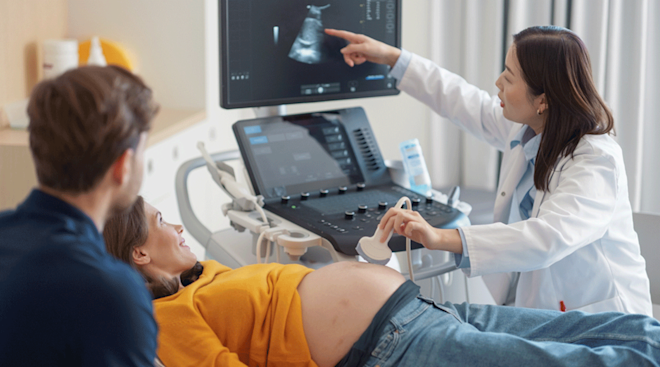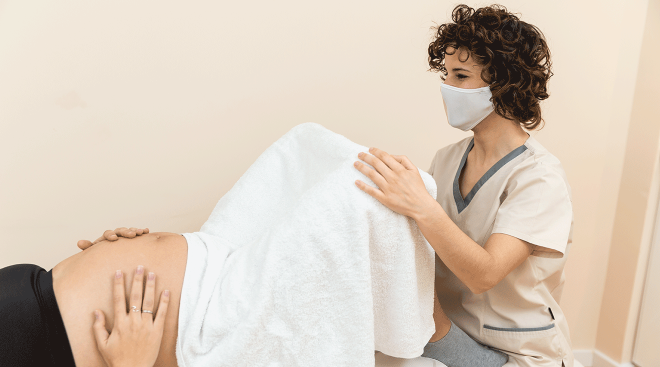Are At-Home Fetal Dopplers Safe?
Imagine you could listen to baby’s heartbeat any time you’d like during pregnancy without making a trip to your OB’s office. An exciting proposition, isn’t it? That’s the appeal of an at-home fetal Doppler device—to let an expectant parent use a fetal heart monitor and connect to baby from the comfort of home. The problem is, in untrained hands, a baby Doppler can give you a false sense of security or set off needless alarms. You could tune in and mistake your own heartbeat for baby’s, or not hear anything at all, creating potential stress for you. If you’re intrigued by at-home fetal Doppler systems, here’s your primer on why you shouldn’t rely on them to monitor baby’s health—and what’s the better option instead.
An at-home fetal Doppler—sometimes referred to as a pocket fetal Doppler—is a handheld baby heart monitor designed to help you hear baby’s heartbeat. The device sends sound waves through your skin and tissue in search of any movement. When movement is detected, the waves bounce back, creating a pattern, which the fetal Doppler records and plays back for you. A pocket fetal Doppler can be found for as little as $40 at your local pharmacy. Many brands claim their dopplers work from 12 weeks on. Still, quality varies from product to product, and even the most advanced home baby Doppler won’t remove the potential for human error.
“They’re marketed as a way to listen to baby’s heartbeat from a really early stage, in order to reassure moms,” says Elizabeth Hutton, CEO of Kicks Count, a U.K.-based nonprofit that aims to educate parents-to-be about tracking baby’s movement. “The claims are very enticing to pregnant women because you want to do everything you can to bond with your baby.”It’s easy to confuse a home fetal Doppler monitor with a Doppler ultrasound machine. The latter is used by a trained professional at your doctor’s office starting around eight weeks into your pregnancy to confirm your due date and check baby’s heartbeat (which begins to beat around the end of week 6!). The main difference between the two? The Doppler ultrasound used in the doctor’s office tends to use higher-frequency sound waves, making it more accurate and reliable. The version used by doctors also provides imaging, whereas the handheld devices offer only sound. But the bottom line is that any type of fetal Doppler monitor is meant to be used only by trained professionals.
“It’s important to know that your health care provider has a lot of experience with different mothers and babies in identifying normal from abnormal,” says Shree Chanchani, MD, a clinical assistant professor of obstetrics and gynecology at NYU Langone Health in New York City. “It’s unlikely that mothers at home have this same experience.”
When used by a trained health professional, fetal heart Dopplers are entirely safe. But in the hands of Mom? Not so much.
In fact, the US Food and Drug Administration (FDA) has advised against the use of at-home fetal Doppler monitors since 2014, noting that devices used to listen to baby’s heartbeat are legally marketed as “prescription devices” and should be used only by trained operators. "When the product is purchased over the counter and used without consultation with the health care professional taking care of the pregnant woman, there is no oversight of how the device is used,” which raises any potential risks to baby and mom, the FDA says.
Why you shouldn’t use a fetal Doppler at home
Using a baby Doppler without proper experience can create a number of problems. First and foremost, these devices aren’t meant to be used by untrained novices at home. . . The potential for confusion or human error is not insignificant. And while this may not sound like a big deal, misuse of the baby Doppler could have serious repercussions. Risks of using an at-home fetal Doppler include:
• Improper use due to lack of training. Doctors, nurses and midwives typically train for a minimum of three years before performing Doppler ultrasounds on pregnant women. Without proper education, you might not be able to interpret the sounds you’re picking up on the baby Doppler. You may think you’re successfully listening to baby, but might actually be hearing your own body or the placenta.
• Unnecessary exposure to waves. Since ultrasounds can slightly heat body tissue, the FDA calls for “prudent” use of ultrasound scans and recommends they be done only when there’s a medical need, under expert supervision. With the use of a home fetal heart Doppler, the administration says, “the number of sessions or the length of a session in scanning a fetus is uncontrolled, and that increases the potential for harm to the fetus and eventually the mother.” While there’s no definitive proof that this can be dangerous to baby, it’s best to minimize risk.
• False sense of security. A home Doppler might lead Mom to think baby is okay and ignore other potential warning signs. If she thinks she hears the heartbeat, she may be less inclined to check in with her doctor.
• False sense of panic. If you can’t find baby’s heartbeat with a home baby Doppler, you might get anxious and incorrectly assume something is wrong. However, it’s possible you’re just not using the device properly. “Fetal Dopplers are safe when used and interpreted by a health care provider, such as a nurse, midwife or physician,” Chanchani says. “They provide real-time information about whether the heart rate of a baby is normal. The risk of using fetal Dopplers at home is not in the technology. The risk is in misinterpreting the fetal heart rate.”
Baby Dopplers will sense all kinds of movement, whether it’s your intestines, the umbilical cord, the placenta or the mother’s heart, which is what many moms actually hear when using a fetal heart Doppler. Because of this, Hutton says, “Women are falsely reassured that baby’s okay and don’t act when they need to—or conversely, they become worried if they can’t find the heartbeat and rush off to the hospital when, really, the baby is perfectly fine.” If you don’t know that your machine is broken, you’re using it incorrectly or baby has moved into a position that makes it hard to detect a heartbeat, you could become unnecessarily panicked. And that stress isn’t great for you or baby.
So what can you do instead of monitoring baby with an at-home fetal Doppler? Starting in the third trimester (at 28 weeks), you can track fetal movement using kick counts, which time how long it takes baby to get to 10 movements. “Doing kick counts help you to get to know your baby’s unique pattern, so you can report any changes from the norm,” Hutton says. “If you know baby is moving properly and normally, that’s a sign the baby is well. When a baby is stressed or is being starved of oxygen, they’ll slow down movement to conserve energy. If you report it to your doctor, professionals can determine what’s wrong, which can have a positive impact on health outcomes.”
In addition to fetal kick counts, Chanchani recommends patients go to their scheduled prenatal appointments and ultrasounds. And if at any time you’re worried baby isn’t moving, call your doctor.
And last, but perhaps most important: Tune into your maternal instincts. “If you have a feeling that something is wrong, then report it—don’t doubt yourself,” Hutton says. “Have confidence in yourself, don’t be tempted to reach for a home Doppler to double-check, confirm or deny whatever it is you’re worried about. Trust your instincts, flag it for your doctor and go get professional medical help.”
A fetal Doppler may sound appealing at first. The idea of being able to check baby’s heartbeat on your own time from the comfort of your own home is tempting. But these devices aren’t made for untrained hands. A baby doppler is best used by an ultrasound technician or medical professional, so think carefully before plucking one off your drugstore shelf.
About the experts:
Shree Chanchani, MD, is a clinical assistant professor of obstetrics and gynecology at NYU Langone Health in New York City. She earned her medical degree from The University of New Mexico School of Medicine.
Elizabeth Hutton, is CEO of Kicks Count, a U.K.-based nonprofit that aims to educate parents-to-be about tracking baby’s movement. Disclaimer
Please note: The Bump and the materials and information it contains are not intended to, and do not constitute, medical or other health advice or diagnosis and should not be used as such. You should always consult with a qualified physician or health professional about your specific circumstances.
Please note: The Bump and the materials and information it contains are not intended to, and do not constitute, medical or other health advice or diagnosis and should not be used as such. You should always consult with a qualified physician or health professional about your specific circumstances.
Plus, more from The Bump:
Navigate forward to interact with the calendar and select a date. Press the question mark key to get the keyboard shortcuts for changing dates.




















































